Honoring Trees: Educator’s Guide
Introduction
Blending the arts with science is a superb way to engage students — and our online art exhibition, Honoring Trees, is an excellent place to begin! This Guide offers educators 60 online resources to harness the power of Honoring Trees in art, science, history, social studies, language arts, and civics classes. We’ve combed the internet to find the resources most likely to stir curiosity, focus attention, encourage reflection and invite response. Help your students experience how stimulating learning can be!
Have students slowly go through the exhibition two times, reading the brief interpretative signs.
- Which image do they find themselves drawn to? Why? Is it the colors, shapes, textures, or feeling they get when looking at the artwork?
- What questions arise from viewing the image? There are no right or wrong answers.
Gather their questions as a guide to choosing among the Supplementary Introductory Exercises and the lesson plan and resources options below.
Topics covered include:
Supplementary Introductory Exercises
Engaging With The Exhibition Images and Text
To reinforce what students have learned so far, have them complete this engaging Trivia Hunt. Each of the twelve reading comprehension questions is followed by a helpful hint indicating where in the exhibition’s interpretative signage students might hunt for the answer.
Explore creativity! We have many ways to express ideas: through storytelling, art, poetry, music, dance, etc. An art exhibition combines visual images and written language to communicate ideas. What other ways could students express thoughts? Have students select one art image from the exhibition. Ask: what subject does the artwork address? Suggest students either:
- Write a poem or song about this subject, or
- Find two more facts about this subject beyond those mentioned in the interpretative signage. Did the artist capture those facts in this artwork? If so, how? If not, how might an artist create a work that does? (This can be either a group discussion or writing assignment.)
Photo: James Balog, Stagg, Giant Sequoia. Fifth largest single living organism on earth. 25.5 ft. in diameter, 242 ft. tall, 44,100 cu. ft. by wood volume, Camp Nelson, CA, Dec. 2001. Photograph. ©2001 James Balog Photography/Earth Vision Institute. Courtesy of the artist. From our Honoring Trees exhibition.
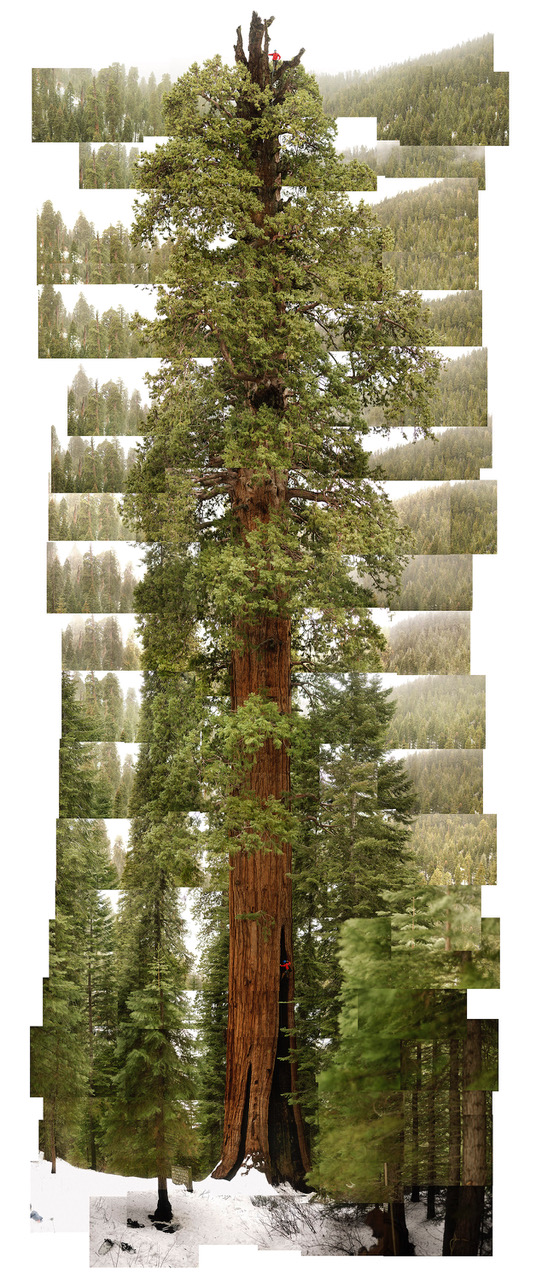
How Have Trees Served Native Americans?

Akwesasne basketmakers (left to right) Nanci Ransom, Sheila Ransom, and Debbie Cook-Jacobs display a basket collaboratively made by the entire Akwesasne community.
Pre-colonial Native Americans depended on trees for food, medicine, fuel, shelter, transportation, and many other benefits. This list describes some of the uses Native Americans found for 6 individual species. Native Americans also used trees as diplomatic symbols. (See How Have Trees Shaped U.S. History, below.)
Today, though forest coverage is greatly diminished, Native Americans still depend on trees to preserve their culture, livelihood, and food supply. The National Museum of the American Indian website documents how four Native American communities are protecting or replanting trees to address contemporary environmental challenges. Five short (2:47 – 6:35 min.) videos introduce each community, their homeland, environmental challenge, strategies, and vision for a sustainable future. Teacher resources include focus questions, a story project planner for students, lesson plans, background information and more.

Sheila Ransom, Basket given to Pope Benedict XVI upon the canonization of Mohawk Kateri Tekakwitha (2012). Black ash and sweetgrass. ©Sheila Ransom, 2012. Courtesy of the artist. From our Honoring Trees exhibition.
Crisscross the country to meet:
- The Akwesasne Mohawks (NY and Canada), who seek to protect black ash trees central to their culture, craft and livelihood from environmental threats and invasive insects.
- The Campo Kumeyaay Nation (CA and northern Mexico), who are planting trees, applying traditional knowledge, and adopting modern technology to restore their dwindling water supply.
- The Leech Lake Ojibwe (ND, MN, WI, MI, and OH and Canada), who seek to protect wild rice beds threatened by human activity such as logging, dam-building, overdevelopment and climate change.
- The Lummi Nation (WA and British Columbia), who are restoring decimated cedar forests in order to revive a disappearing salmon population.
How Have Trees Shaped U.S. History?
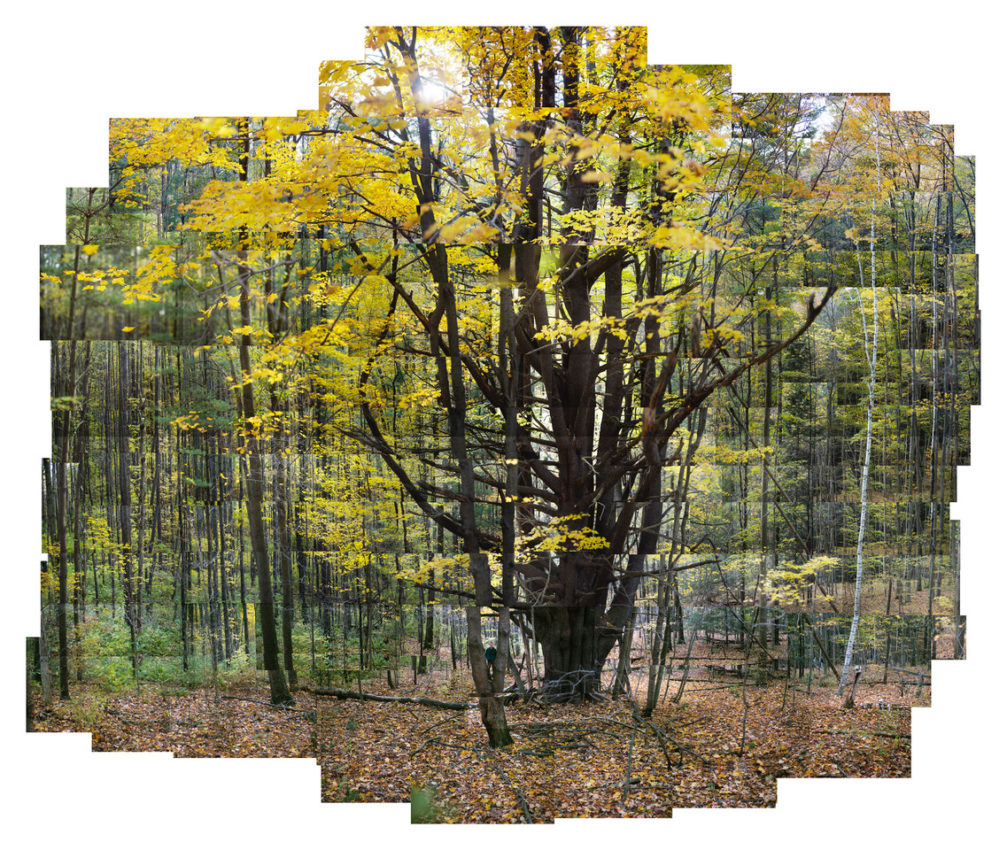
James Balog, Eastern White Pine, Lenox, Massachusetts, October 2002. Photograph. ©2002 James Balog Photography. Courtesy of the artist. From our Honoring Trees exhibition.
The history of the United States can be traced through our trees. Here are a few intriguing examples:
When five warring Native American nations united to form the Iroquois Confederacy, they buried their weapons beneath a white pine tree. This “Tree of Peace” symbolized the “Great Law of Peace,” which still guides the Iroquois. In 1987, the U.S. Senate formally acknowledged the influence of the “Great Law of Peace” on the U.S. Constitution. The Haudenosaunee Guide for Educators recounts this history, introduces Haudenosaunee (Iroquois) culture, suggests discussion questions and craft projects, and outlines a plan for creating a class constitution for peace (e.g., no bullying).
George Washington took a keen interest in trees. After the Revolutionary War, he re-landscaped Mount Vernon to impress the hundreds of visitors he would now be receiving. Dean Norton, Mount Vernon’s Director of Horticulture, explains how Washington used trees to create a naturalistic setting in this (1:49 min.) video below.
This article describes Washington’s final landscape plan.
President Lincoln’s efforts to protect Giant Sequoias for public benefit laid the foundation for our National Parks. Segregated “Buffalo Soldier” troops assigned to protect two of our earliest National Parks, Yosemite and Sequoia, pioneered park management.
National Park Service webpages provide a brief history of the Buffalo Soldiers and a biography of Colonel Charles Young, their charismatic leader. Ranger and historical impersonator Shelton Johnson makes this history come alive in a (11:31 min.) video (below) showing how Buffalo Soldiers had to overcome racist language and attitudes as well as daunting wilderness challenges. A shorter (2:32 min.) video of their conservation legacy is available here.
Language arts and history teachers might also be interested in A Buffalo Soldier Speaks, a series of weekly audio podcasts in which Johnson, relying on historical research and his own imagination, recounts the experiences of an actual 19th century park ranger, Elizy Boman, about whom little is known.
What Can Trees Do for Us?
The answer is a lot! Tree Facts explains the terrific things trees do for us every day. (For younger students, see this simple slide show with a free printable activity sheet to reinforce the lesson.)
Urban Trees, a (4:45 min.) video (below), shows how trees make cities more healthy and livable – and how we can protect trees.
Extreme heat events already kill hundreds of Americans each year and will become more common, severe and long lasting as climate changes. A Center for Disease Control (CDC) booklet explains why – and what you can do to prepare (including planting trees). Younger students may prefer a handout of the booklet’s easy-to-understand charts and graphic illustrations.
Arizona State University offers a series of lesson plans exploring urban heat islands and their impact on humans and animals. At the conclusion of the series, an engineering project challenges students to design a thermally efficient house.
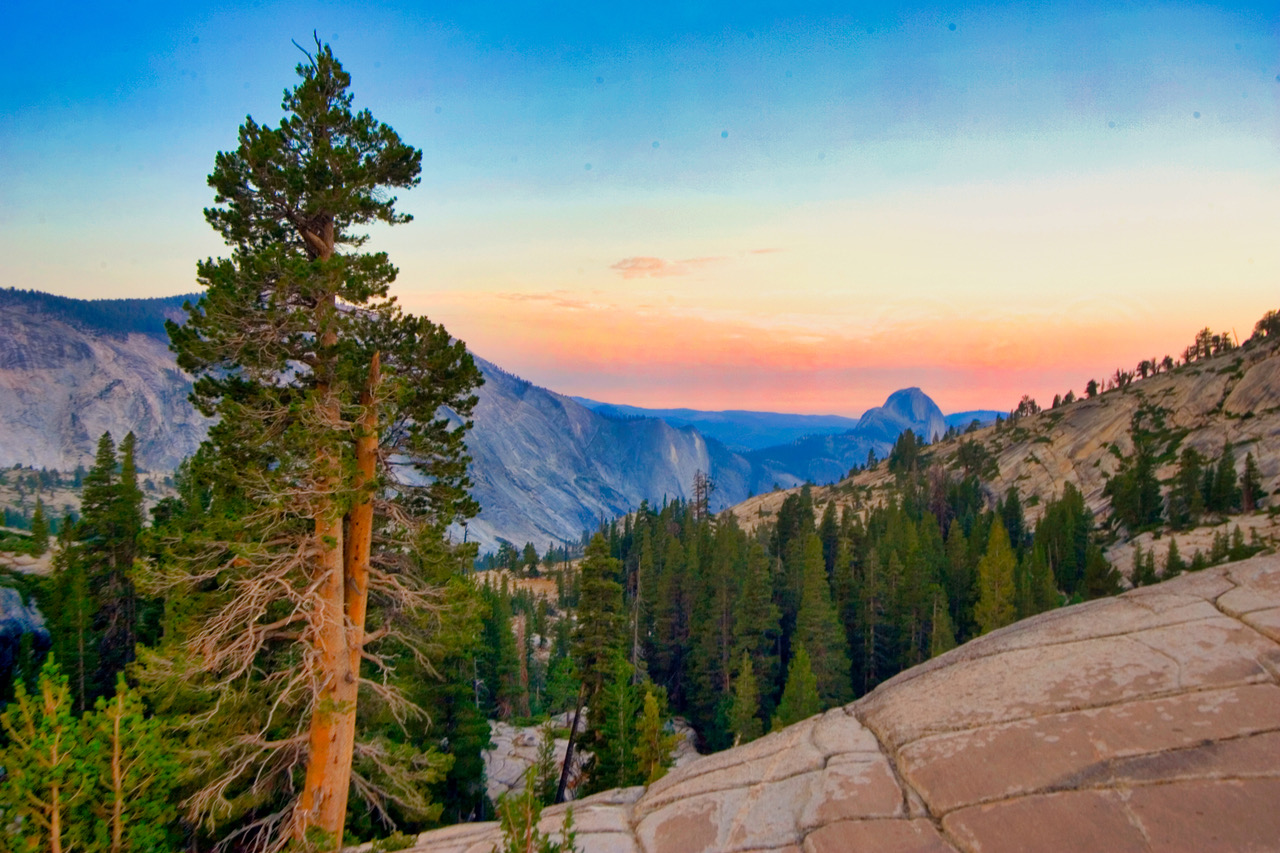
Dudley Edmondson, Yosemite High (2005). Photograph. ©Dudley Edmondson. Courtesy of the artist. From our Honoring Trees exhibition.
Trees connect us to our past. In the (6:31 min.) video Yosemite Ranger Talk (below), National Park Service Ranger Shelton Johnson marvels at the history, geology, and awe-inspiring magic of Yosemite, where Giant Sequoia trees, granite cliffs, and majestic waterfalls offer the same astonishing vistas that greeted early explorers and Native Americans.
What Tree Is That?
There are over 60,000 tree species in the world, 10,000 of which are endangered. The U.S. Forest Service has identified more than 700 tree species in the U.S. alone.
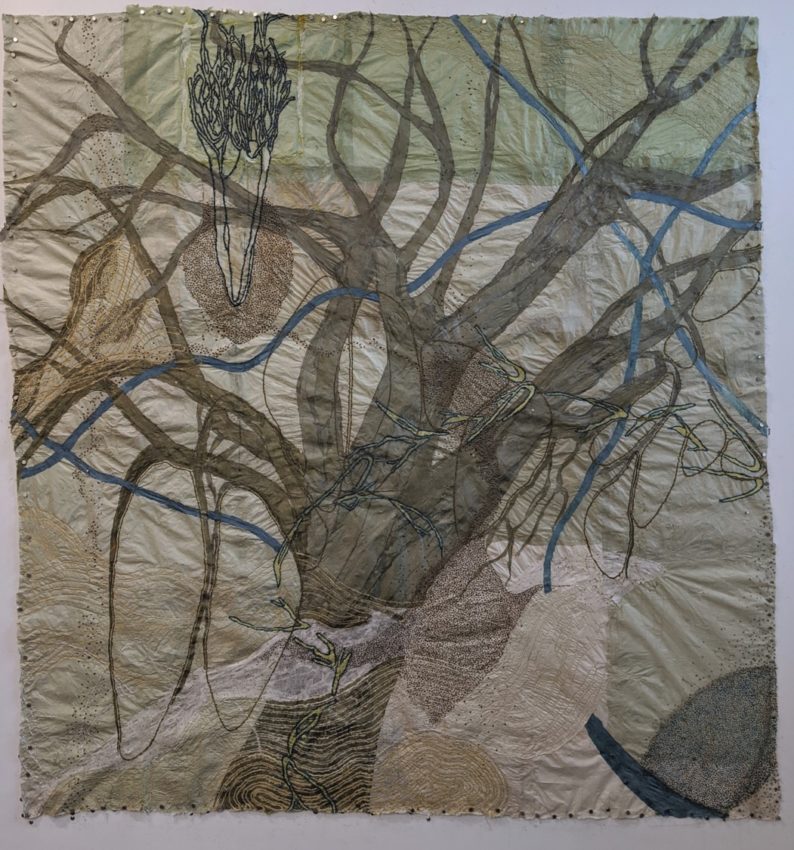
Nancy Cohen, Settling In (2019). Paper pulp, ink and handmade paper. Dimensions: 77 x 73 inches. ©Nancy Cohen 2019. Courtesy of the artist. From our Honoring Trees exhibition.
In 2004, by vote of the American people, the oak tree became the official U.S. National Tree. This short article explains the fascinating selection process and the reasons why the mighty oak prevailed over other popular species. (Each State and territory also has its own “State Tree.” To find your State tree, see the U.S. National Arboretum’s list of official State Trees.)
Curiosity about different tree species can lead to a tree identification assignment. The Arbor Day Foundation offers an easy step-by-step guide to tree identification. The Penn State College of Agricultural Sciences’ Summer Key for Pennsylvania Trees also offers step-by-step guidance to identify mid-Atlantic and Northeast U.S. trees. Either guide can assist with identifying trees on school property, in a local park, or in students’ backyards or neighborhoods. Students can complete this lesson by writing a poem, creating an artwork about a favorite tree, interviewing an arborist (perhaps a class or online visit can be arranged?), or helping to plant a tree on school grounds.
The Superpower of Observation: I Notice, I Wonder, It Reminds Me Of, a (8:28 min.) video (right), teaches students to think like a scientist. Educator Kayla David uses simple binoculars (made from toilet paper rolls), the power of observation, and prior knowledge to identify a found object – a silver maple tree seed. Resources include a downloadable lesson plan and worksheet.
Students can also make – or confirm – the identity of a tree species with Leafsnap, an electronic field guide developed by Columbia University, the University of Maryland, and the Smithsonian Institution. The Leafsnap app – downloadable for free on an iPhone or iPad – uses visual recognition software to identify tree species from photographs of their leaves. A (1:53 min) video (left) introduces the app to students.
What’s Happening Underground?
How Trees Secretly Talk to Each Other, a (1:47 min.) video (below), explains how trees use a network – nicknamed the “wood wide web” – of fungi in and around roots to share resources, warn neighbors of attacks, and, at times, sabotage rivals. Colorful, animated graphics make what’s happening underground easy-to-visualize and highly intriguing.
Investigate the mystery of underground tree growth alongside scientists from the Bartlett Tree Lab in Finding Roots, a (5:02 min.) video. Support materials include discussion questions and can lead to several research options, including electromagnetic induction tools used in earth science, the role trees play in urban health and wellness, and how trees in urban areas impact energy efficiency.
Explore one of the world’s most amazing root systems! Red Mangroves: The Strangest Roots & Fruits, a (8:07 min.) video (below), takes you to a Florida mangrove forest. Students may get a chuckle watching narrator Stephen Brown disentangle himself from a web of mangrove roots, but they will get the point: these roots are thick and coastline-protective!
Red, white, or black mangrove tree – how can you tell the difference? Florida Sea Grant and Lee County Extension agent Joy Hazell shows you the unique properties of each in How To Identify the Three Types of Mangroves, a (4:08 min.) video (below).
How Do Trees Help Combat Climate Change?
NASA’s Climate Kids program offers three animated videos to introduce students to the concepts of climate, climate change, and the greenhouse effect. Students may benefit from exploring these concepts before tackling how trees help combat climate change:
What’s the Difference Between Weather and Climate
A (2:00 min.) animated video, with a downloadable poster to reinforce the lesson.
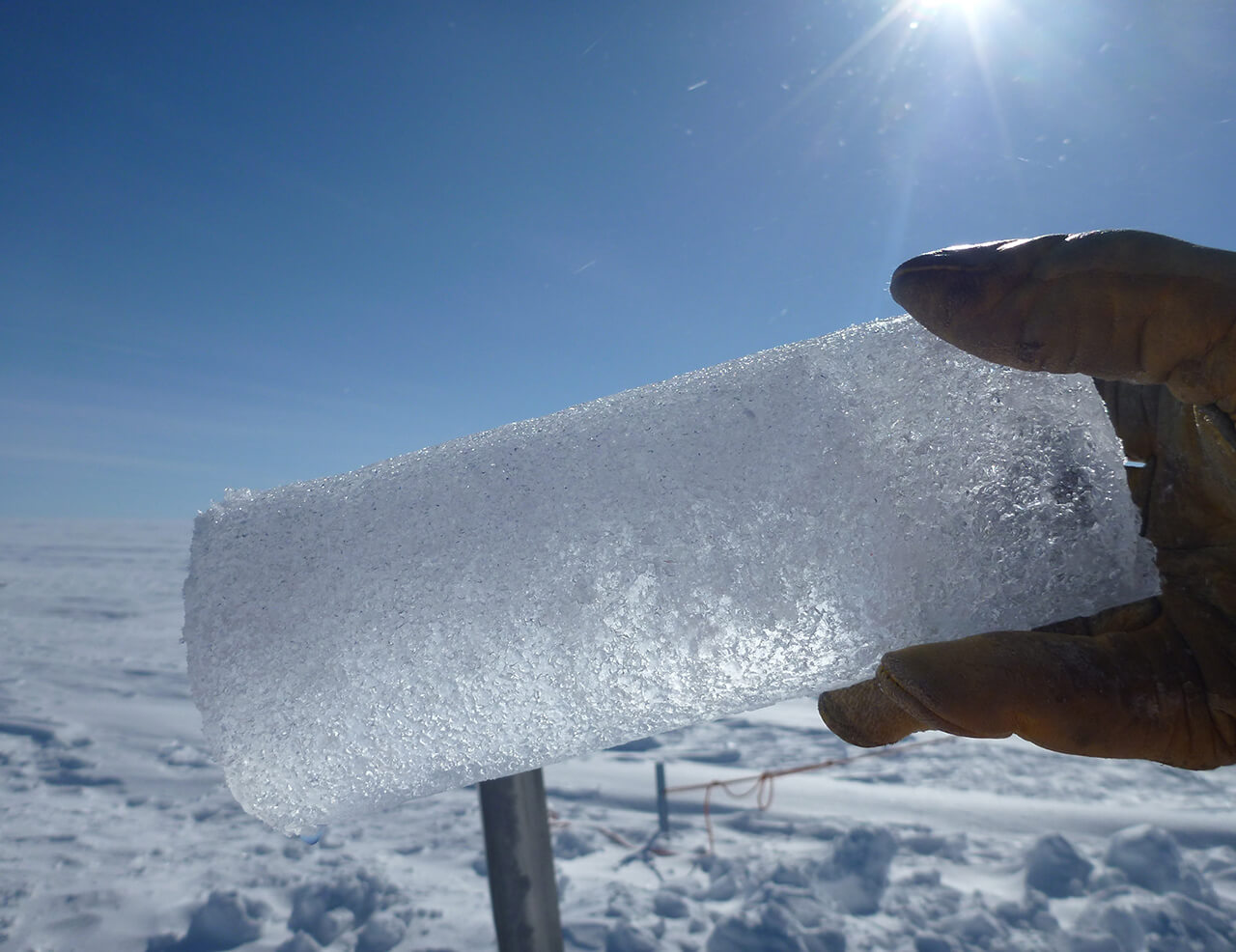
How Do We Know The Climate Is Changing?
A fact sheet with a (00:54 min.) animation illustrating the loss of Arctic sea ice from 1979 to 2018.
What Is the Greenhouse Effect?
A (2:30 min.) animated video and online webpage explaining the basic concepts behind the greenhouse effect.
What Can Trees Tell Us About Climate Change, a NASA fact sheet, explains how scientists use tree rings to learn about climate hundreds – even thousands – of years ago.
Three National Park Service videos show how forests serve as learning laboratories for studying the impacts of climate change. These videos can deepen students’ understanding of three key concepts:
- how certainty about the reality of climate change can coexist with uncertainty about the full extent of its impacts,
- the enormous amount of data scientists need to gather to be able to attribute observed changes in plant and animal behavior to climate change, and
- the importance of gathering this data to help us prepare for a climate-changed future.
Phenology and Citizen Science in the Great Smoky Mountains, a (8:33 min.) video, explains how students are gathering phenological data (i.e., data on the timing of natural events such as the arrival of birds, frogs singing, or plants blooming) in the Great Smoky forests to help scientists understand whether variations from historic norms are due to climate change.
Species Loss, Precipitation and Fire in Sequoia National Park, a (9:13 min.) video, focuses on adaptation to climate change. Scientists explain how they document and analyze changes to the forest (such as warmer temperatures, reduced snow cover, longer and dryer fire seasons) to identify and prepare for upcoming management challenges.

Species’ Range Shifts at Sequoia-Kings Canyon National Park, a (8:30 min.) video, provides a useful foundation for engaging students in the challenges of science communication. The video presents the strengths and limits of science in helping us prepare for novel futures. It concludes with a question: how can we excite the public about climate policy conversations? After watching the video, students can be asked to discuss: how can we express the complexity of climate science in a sound-bite world? And, given that over 32,000 animal species are threatened with extinction (see the International Union for Conservation of Nature report), how would you phrase an appeal to the public about recognizing the importance of climate change?
Reforestation: Impact on Climate, a (3:37 min.) Nature Conservancy video, introduces vocabulary like carbon cycle, carbon sequestration, and ecosystem services and explains how planting trees decreases CO2 in the atmosphere.
En-ROADS is an online simulator developed by Climate Interactive and the MIT Sloan School of Management to show how different mitigation strategies might affect global temperature rise, based on what the authors consider to be the best scientific data currently available. Using their estimates, students can compare the benefits of various policy choices and design a strategy to cap global temperature rise at 2°C. The simulator would show, for example, that creating new forestland (“afforestation”) and stopping existing forest loss (“deforestation”) are important, but not sufficient, strategies. The En-ROADS homepage provides a (3 min.) introductory video (“En-ROADS Overview”) and a link to the beta version of the simulator.
Climate Literacy: The Essential Principles of Climate Sciences is a guide for educators who teach climate science to meet content standards in their science curricula. The guide, developed by the National Oceanic and Atmospheric Administration (NOAA) and the American Association for the Advancement of Science with contributions from science agencies and nonprofit organizations, outlines how humans influence climate and how climate influences humans.
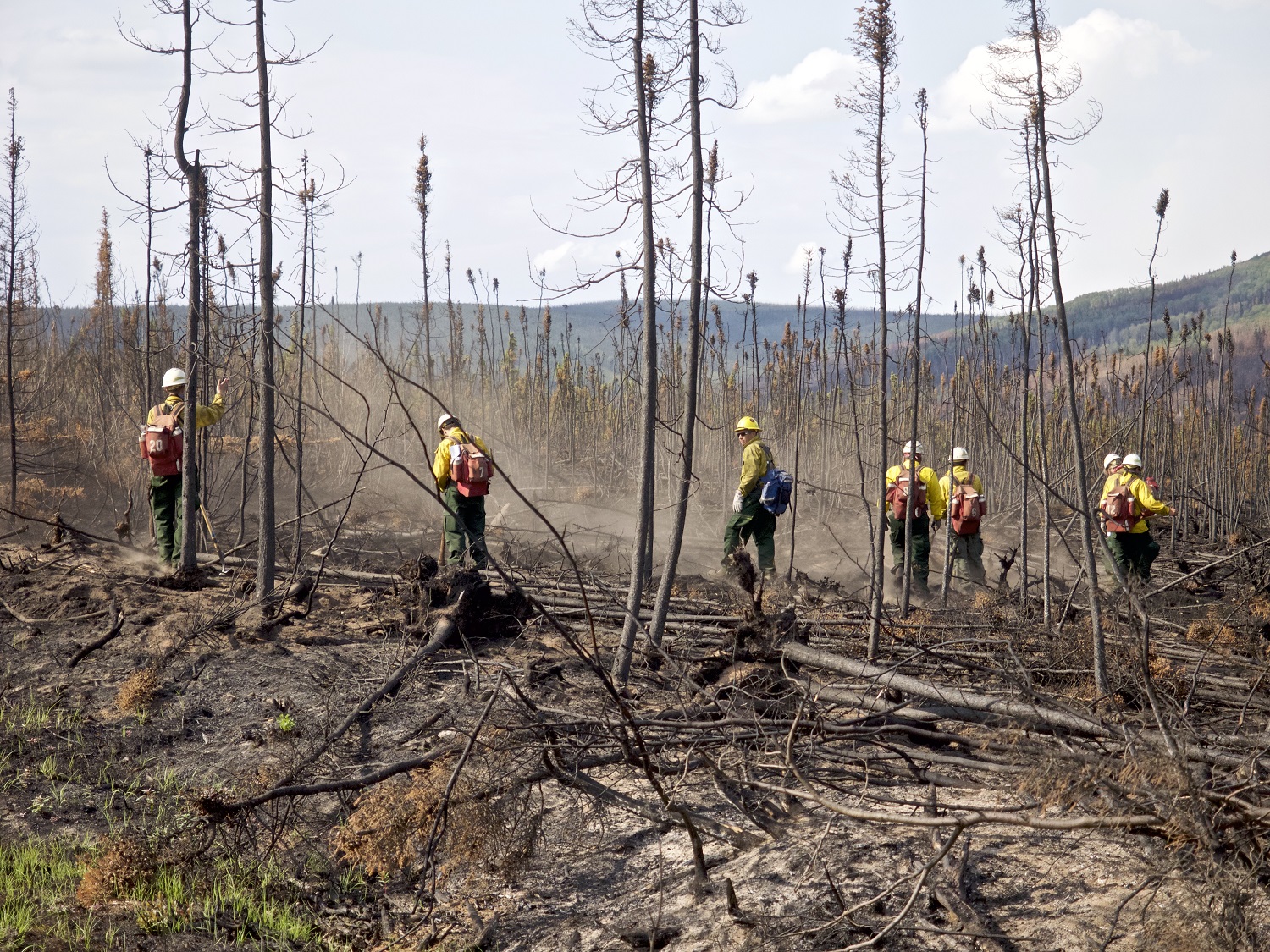
Peter Handler, Firefighters at Aggie Creek (2015). Photograph. © Handler Studio 2015. From our Honoring Trees exhibition.
How Do Trees Clean Waterways?
Healthy watersheds are critical to the survival of all life on earth. Clean Water: A Long Journey from the Source to Our Tap, an animated (2:19 min.) graphic (below), explains the connection between clean tap water and surrounding land use.
How Nature Makes Clean Water, a (4:06 min.) video (below), describes the concept of a watershed and shows how building rain gardens can improve watersheds.
This more advanced lesson plan from KidsGardening discusses the water quality impacts of pervious and impervious surfaces and includes instructions for guiding students in rain garden design. Students can research the native tree and shrub species of your area and find grants to make the design a reality at KidsGardening and Whole Kids Foundation!
Students may also use information gleaned in this unit to explore the creative challenges and rewards of a career as a science communicator. For inspiration, see Riparian Buffers, a high school student’s award-winning (4:09 min.) video explaining the importance of riverbank buffers to plants, animals and water quality.
How Do Trees Help Animals (And Animals Help Trees)?
Claire Kelly created Parallax: Busy Forest (see image below) to spur us to explore the worlds where animals dwell. Each of the resources in this section examines those worlds. Begin by asking students to discuss:
- What lessons can we learn from these animal worlds?
- Claire Kelly takes a playful, “gentle” approach to raising environmental awareness; other artists in this exhibition chose to be more informative or startling. Which approach would you take and why?
![Claire Kelly, Parallax: Busy Forest (2019). [Parallax: The effect whereby the position or direction of an object appears to differ when viewed from different positions.] Glass: Blown, sculpted, and assembled. Dimensions: 15 ¼ x 16 x 36.” © Claire Kelly Glass. Courtesy of the artist. Kelly’s playful glass sculptures invite us to enter and explore the worlds where animals dwell. She aims to stir our curiosity about the animals within this intimate kingdom: what is their role in, and value to, the larger ecosystem? What threats await them? And, most importantly, what do they see when they look back at us? Her work presents “a gentle mirror” for examining how our decisions affect our environment.](https://www.honoringthefuture.org/wp-content/uploads/2020/02/Kelly_Claire_Parallax_Busy-Forest-1.jpeg)
Claire Kelly, Parallax: Busy Forest (2019). [Parallax: The effect whereby the position or direction of an object appears to differ when viewed from different positions.] Glass: Blown, sculpted, and assembled. Dimensions: 15 ¼ x 16 x 36.” © Claire Kelly Glass. Courtesy of the artist. From our Honoring Trees exhibition.
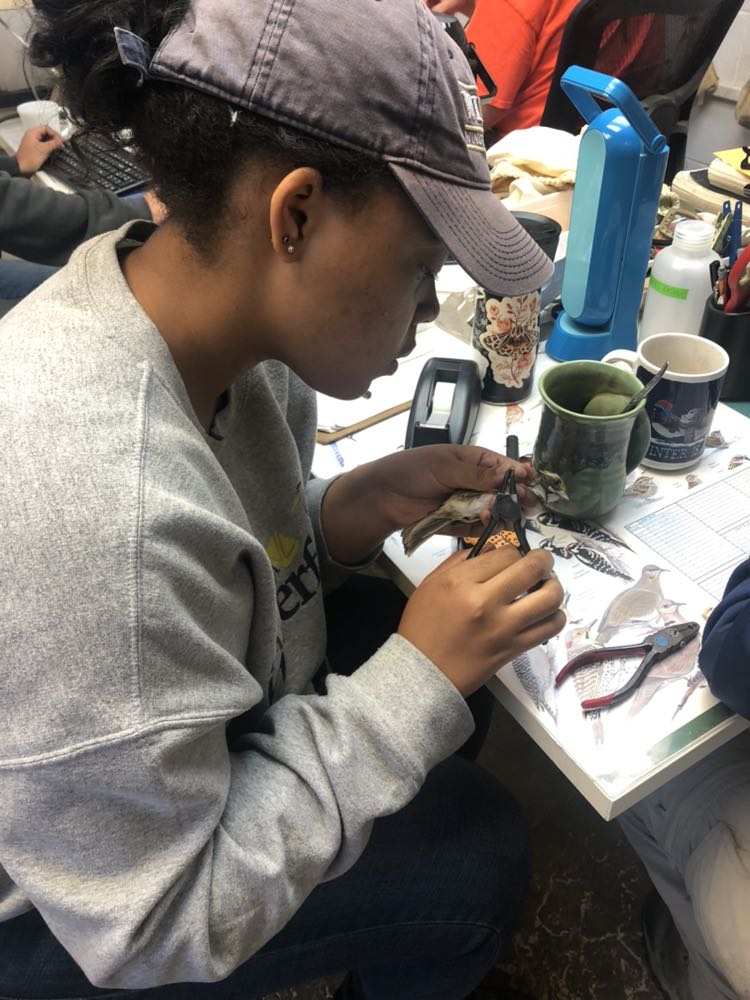
Lauren D. Pharr researching the effects of urban noise and light pollution on bird survival in the Washington, DC area.
Ornithologist and science communicator Lauren Pharr infuses clear explanations of science with an infectious passion for birds. In her short online article, What Do Trees Do for Birds (And Birds Do For Trees)?, she introduces the concept of an ecosystem and explains how trees and birds depend on each other to function and survive.
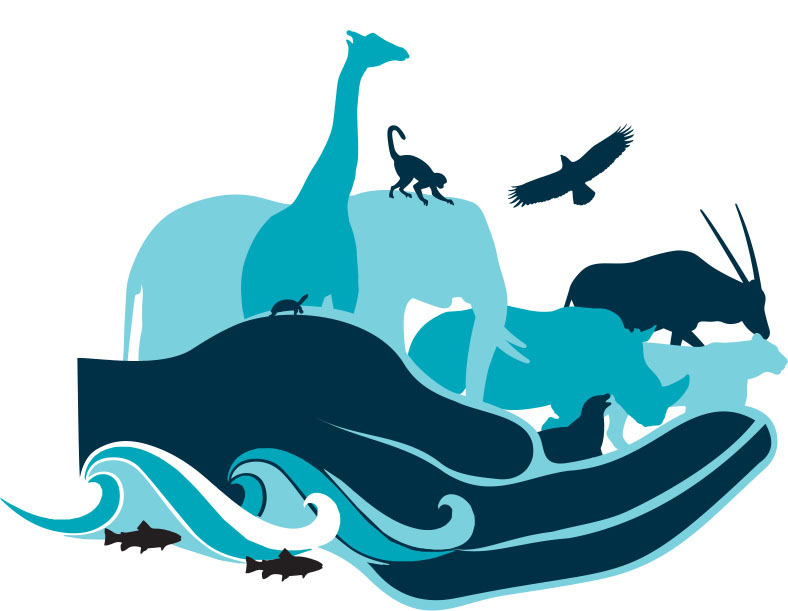 Trees provide critical habitat for animals. As humans clear forests for agriculture, mining, infrastructure and development, animals are killed, displaced or orphaned. Survivors are confined to smaller, often isolated, plots where prey is lacking, food sparse, and interaction with others limited, threatening genetic diversity. The respected International Union for Conservation of Nature reports that more than 32,000 animal species are threatened with extinction. Our We, The Ark online exhibition profiles 13 of these species and suggests ways to integrate these profiles into class curricula.
Trees provide critical habitat for animals. As humans clear forests for agriculture, mining, infrastructure and development, animals are killed, displaced or orphaned. Survivors are confined to smaller, often isolated, plots where prey is lacking, food sparse, and interaction with others limited, threatening genetic diversity. The respected International Union for Conservation of Nature reports that more than 32,000 animal species are threatened with extinction. Our We, The Ark online exhibition profiles 13 of these species and suggests ways to integrate these profiles into class curricula.
Increasingly, governments and nonprofit organizations are developing programs to preserve vulnerable and endangered species. While there have been notable conservation successes, the task is not easy. The Borneo Orangutan Survival Foundation’s (8:26 min) video (below) demonstrates both the rewards and challenges of finding new habitat for orangutans orphaned or displaced by forest destruction.
How Can Humans Protect and Preserve Trees?
Travel to Thailand to witness a successful mangrove restoration project. See and hear from the villagers who help implement it in Restoring The Natural Mangrove Forest, a (10:00 min.) video from the Mangrove Action Project.
For more information on mangroves, see:
The Importance of Mangrove Forests, a (1.18 min.) animated video explaining the many ways these ingenious trees benefit coastal communities.
Think Mangrove Forests, a (2:02 min.) animated video, explaining the ecological benefits of mangroves, the threats they face from human activity, and simple steps we can take to help preserve mangroves.
The Wondrous Mangrove Forest, a (1:00 min.) animated video, introducing the flora and fauna of Florida’s mangroves.
What Can Students Do to Help?
Speak up!
What would you like to tell the world about climate change? Honoring the Future’s Climate Art Mosaic offers students the opportunity to join others in voicing their concerns, hopes and ideas about climate change.
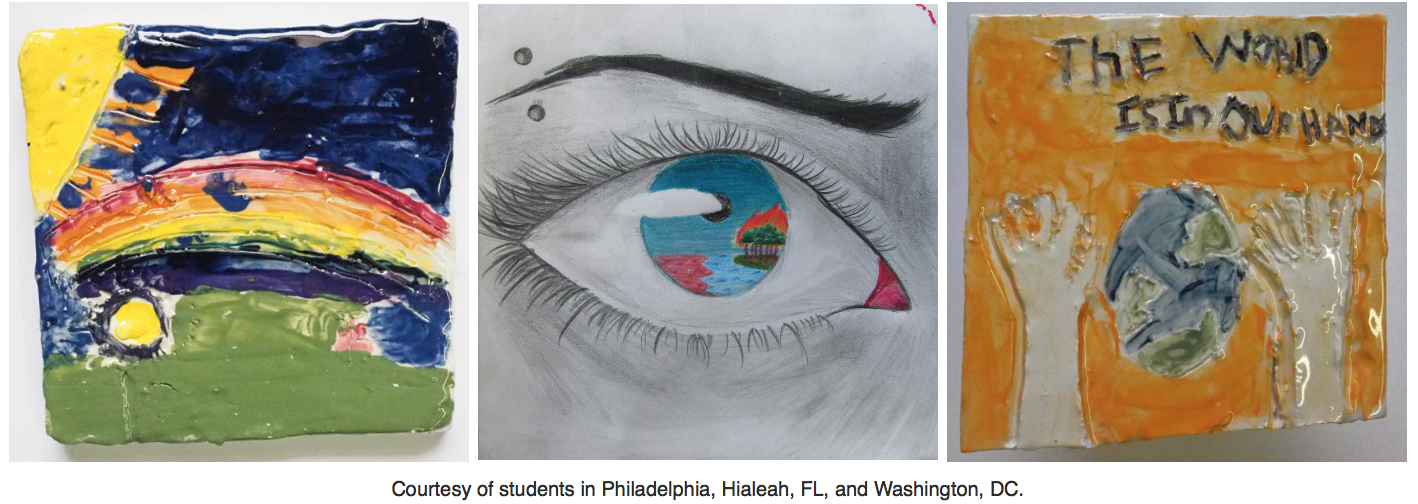
Artist Olafur Eliasson’s new interactive artwork, Earth Speakr, uses augmented reality to invite kids to speak up for the planet and adults to listen to what kids have to say. Join the fun! Hear Eliasson explain the app in this (2:25 min.) video.
Be creative!
Participatory art projects can be powerful catalysts for sparking conversation about climate change! Artist Xavier Cortada’s Plan(T) is an excellent model. To create community awareness and begin preparing for rising sea levels, the project encourages every Miami-Dade county resident to plant a mangrove seedling in their yard alongside a flag indicating the property’s elevation over sea level. Students serve as project emissaries, dispensing seedlings, creating public exhibits about the project, speaking at public libraries, and distributing flyers at the local farmer’s market.

Artist Xavier Cortada explaining Plan(T), his participatory art project encouraging community-wide planting of mangrove seedlings.
Design a Trail is a National Park Service lesson plan for engaging students in writing, illustrating, and producing an interpretive walking trail for a natural or cultural setting. If desired, participating students could also lead younger grades on interpretive walks around the trail.
Riparian Buffers, a (4:09 min) video discussed above, shows how one motivated student with a camera can educate others about protecting habitat for trees. It may inspire students to create their own educational videos.
Become a community scientist!
Help NASA learn more about trees! GLOBE Observer: Trees is an app-based tool that allows students to send estimates of tree height to NASA. NASA uses the data to assess the density of tree coverage in local areas, track how trees change over time, and calculate the carbon that trees and forests absorb or release to the atmosphere. Students can become part of a 6-continent wide global research campaign that includes students, educators and scientists from over 50 countries. The campaign website will feature regular webinars, live social media events and blogs.
Organize for action!
In Mayah’s Lot, a downloadable comic book and civics tutorial, an aspen tree becomes a metaphor for a low-income community’s efforts to come together and oppose a proposed toxic waste dump in their already highly polluted neighborhood.
Young Voices for the Planet provides short (3½ – 8½ min.) online films highlighting student leadership on climate action:
Green Ambassadors (4:27 min.) High school students plant trees, educate students about sustainability, and act to reduce carbon dioxide emissions.
Save Tomorrow (7:21 min.) Three nine year-olds testify before the town council and help enact a law allowing solar panels on public buildings. The students also organize youth to protect a local forest.
Plant for the Planet (5:32 min.) Eleven year-old Felix Finkbeiner decided to plant a million trees to reduce the level of carbon dioxide in the atmosphere. His efforts helped launch Plant for the Planet.
Dreaming in Green (6:22 min.) Middle school students conduct a school energy audit and save their school $53,000.
We thank our Nature Educator JoAnn Coates-Hunter for her vision, inspiration and guidance throughout this project.


